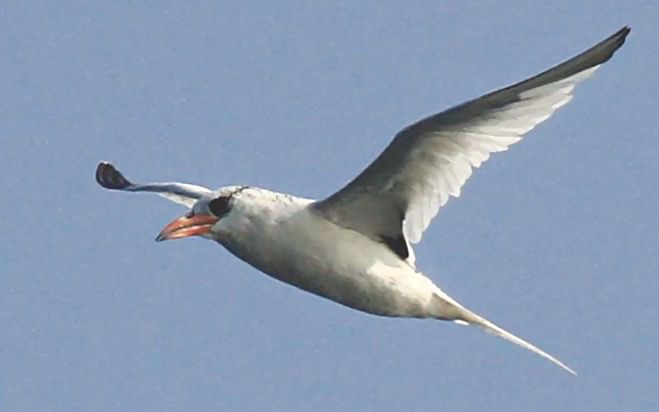Our First Tropicbird
Our First Tropicbird

Most birds either live on land or in waters close to land. Some birds, on the other hand, live in the open seas. They are known as pelagic birds. They can fly for many hours and can be found hundreds or even thousands of miles from the shore. Most of them spend their lives over water except when they breed. For example, certain Albatrosses have no need for land until they are old enough to lay eggs, perhaps six or seven years. Since we cannot observe them easily, much is unknown about pelagic birds.
On 1st January, 2014 at 1pm, a small team of birders - Tarek Onu, Shamim Ahmed and leader Enam Ul Haque - brought a new year's gift for the nation. Forty kilometres from our coast in the Bay of Bengal, while aboard the fishing trawler M.V. Labiba, they sighted a Red-billed Tropicbird. It was the first sighting of this rare pelagic bird in Bangladesh. Two other pelagic birds are also listed in Bangladesh: Parasitic Jaeger and Pomarine Skua. However, the Tropicbird was our first pelagic sighting out in the high seas.
Tropicbirds are only seen in oceans in the tropics. There are three species; the other two are Red-tailed and White-tailed Tropicbirds. In flight, they are easily recognized by their beautiful long tail which hangs behind like a streamer. Their breeding grounds are unknown. Not surprisingly, they live on fish and marine animals; surprisingly, most of the fish they eat are flying fish. They can be large, up to a meter in length and wingspan.
The Bangladeshi team left on its ten-day expedition on 26 December 2013 on board the commercial fishing trawler bound for the Bay of Bengal. When they were close to shore, they saw shorebirds such as gulls and terns. But birds became rare out in the open seas. For example, ten to twelve kilometres from shore, two Pallas's Gulls were sighted. Because pelagic birds could come and go in a flash, the team had to keep vigilant watch during daylight hours. The trawler with forty-five fishermen tossed and turned in the rolling sea while looking for fish, so it was tough going for the birdwatching team.
Their effort was rewarded on the sixth day of the trip. At about 1PM, the Tropicbird flew over the boat. The team was ready and photographed it. There was only one opportunity – the bird did not linger or return, but the identification was unmistakeable.
Since this was the first such expedition searching for birds in our high seas, I asked Haque about the possibility of discovering other pelagic birds in Bangladesh. “We should make more frequent birding expeditions to the high seas – perhaps once or twice every year,” he said. “They could reveal other treasures in our oceans.”
The Tropicbird was hitherto unknown here and so there is no Bangla word for it. Recalling the Bangla word for tropic is “Bishubrekha”, the team has chosen the Bangla name “Bishubia” for the Red-billed Tropicbird, our new pelagic treasure.
www.facebook.com/tangents.ikabir